Topics
Category
Era
Industrial Exposition Building, Minneapolis
Built in less than a year, the Industrial Exposition Building in Minneapolis housed the city's first Industrial Exposition in 1886 and the Republican National Convention of 1892. It dominated the Mississippi riverbank east of St. Anthony Falls for decades.
The idea for an exposition in Minneapolis arose in August 1885, when it became known that St. Paul had secured the permanent home of the Minnesota State Fair. Prominent citizens of Minneapolis such as Minneapolis Tribune owner Alden Blethen felt slighted, and an open meeting was called to gauge public support for an annual Minneapolis industrial fair, or exposition, to rival St. Paul's agricultural one.
The public liked the idea. Supporters raised funds throughout the fall of 1885 and reached their goal of $250,000 on December 15. The Industrial Exposition Association was incorporated in January 1886 and the site of the Winslow Hotel was chosen for the new, permanent Industrial Exposition Building. The Winslow, one of the earliest hotels in the region, was torn down to make way for the new structure.
Many architects, including Leroy Sunderland Buffington, submitted designs for the building, but the firm of Isaac Hodgson and Son was chosen. The cornerstone of the Industrial Exposition Building was laid with fanfare on May 29, 1886, during a public ceremony attended by more than five thousand people.
The first exposition in the building was scheduled for August 1886. Some doubted the structure would be ready in time, but workers labored through the summer and the building was done on schedule. The main section of the building was just three stories high, but the tower at the building's northwest corner, which featured a public observation deck, rose 240 feet into the air, making the Industrial Exposition Building the tallest structure in Minneapolis at the time.
On August 23, 1886, there was a grand celebration for the opening of the new building and its first exposition. Local dignitaries such as Senator Cushman K. Davis and Archbishop John Ireland spoke at the dedication. US President Grover Cleveland and his wife Frances could not attend. However, they sent a congratulatory telegram that was read publicly, and then in a dramatic moment, Mrs. Cleveland touched a special button in her New York location that started all of the machinery in the building.
Thousands of people attended the fair on its first day and each day of its first run, through October 2. The fair averaged 8,000 tickets sold per day, but because free passes also were distributed, daily attendance may have been as high as 15,000. The latest technology and industrial developments were on display, as were the fine arts, with a large gallery set aside for paintings and sculptures acquired in Europe and New York.
In its first year, the exposition was a financial and popular success, and in 1887, attendance and revenue held steady. But in the following years, excitement lessened and the exposition began to lose money. Minneapolis could not have attracted the Republican National Convention of 1892 without the Industrial Exposition Building, but the convention was not enough to halt the exposition's decline. By 1893, exhibitors had evaporated and the fair had fallen apart.
In 1896, Thomas B. Janney bought the building at public auction for $25,000, a fraction of what it cost to build. For the next seven years, the space was used sporadically as a performance venue. It hosted the first concerts of what later became the Minnesota Orchestra and welcomed famous musicians and performers including Johann Strauss and New York's Metropolitan Opera. In 1903, Marion Savage, owner of race horse Dan Patch, bought the building and turned it into the International Stock Food Company.
In the 1930s, the building became a mail-order facility where clerks traveled across the large interior spaces on roller skates. The building's final owner, the Coca-Cola Company, tore it down in 1940 to make room for a new bottling plant, leaving just the northwest tower. The tower stood for a few more years as a remembrance of what was once one of the most prominent buildings in the city.
Bibliography
"Art for the Exposition." Minneapolis Tribune, June 16, 1886.
Atwater, Isaac, ed. History of the City of Minneapolis, Minnesota. 2 vols. New York: Munsell and Company, Publishers, 1893.
Ausenhus, Peter. "Civic Image and the building of the Minneapolis Industrial Exposition." PhD diss., University of Minnesota, 1996.
Berman, James, ed. Saint Anthony Falls Rediscovered. Minneapolis: Minneapolis Riverfront Development Coordination Board, 1980.
"The City: Enthusiastic Mass Meeting in Favor of the Industrial Exposition," Minneapolis Tribune, October 17, 1885.
Dees, Janis White. "Anna Schoen-Rene: Minnesota Musical Pioneer." Minnesota History 48, no. 8 (Winter 1983): 332–338.
http://collections.mnhs.org/MNHistoryMagazine/articles/48/v48i08p332-338.pdf
Edgar, Randolph. "Early Minneapolis Theaters." Minnesota History 9, no. 1 (March 1928): 31–38.
http://collections.mnhs.org/MNHistoryMagazine/articles/9/v09i01p031-038.pdf
"The Exposition." Minneapolis Tribune, May 29, 1886.
"Exposition." Minneapolis Tribune, August 24, 1886.
Holmquist, June Drenning. "Convention City: The Republicans in Minneapolis, 1892." Minnesota History 35, no. 2 (June 1956): 64–76.
http://collections.mnhs.org/MNHistoryMagazine/articles/35/v35i02p064-076.pdf
"Industrial Exposition." Minneapolis Tribune, September 22, 1885.
Landscape Research LLC. The Minneapolis Riverfront as Birth Place and First Place. Prepared for the Saint Anthony Falls Heritage Board, 2008.
"The Minnesota Scene." Minnesota History 36, no. 1(March 1958): 33.
Sherman, John K. "The Birth of a Symphony Orchestra." Minnesota History 33, no. 3 (Autumn 1952): 93–104.
http://collections.mnhs.org/MNHistoryMagazine/articles/33/v33i03p093-104.pdf
Thompson, Ruth. "Minnesota Memories." Minneapolis Tribune, October 8, 1945.
"Triumph!" Minneapolis Tribune, October 11, 1885.
Related Resources
Primary
P1547
George A. Brackett Papers, 1858–1920
Manuscript Collection, Minnesota Historical Society, St. Paul
Description: George Brackett was involved in planning the first Industrial Exposition in Minneapolis in 1886.
A/.G762I
Lewis A. Grant and Family Papers, 1781–1921
Manuscript Collection, Minnesota Historical Society, St. Paul
Description: Lewis A. Grant was a stockholder in the Minneapolis Industrial Exposition.
Art catalogue, 1891 Minneapolis Industrial Exposition, sixth annual exhibition. Minneapolis: Harrison and Smith, 1891.
Catalogue of paintings and casts from the antique, etc., 1889 Minneapolis Industrial Exposition. Minneapolis: Swinburne Print Co, 1889.
Catalogue of paintings of the art department, third Minneapolis Industrial Exposition. Minneapolis: Swinburne Print Co, 1888.
Catalogue of works of art and antiquities in the art galleries of the Minneapolis Industrial Exposition 1890. Minneapolis: Swinburne Print Co, 1890.
Chapin, Harold C. Minneapolis industrial and art exposition souvenir and illustrated hand book. Minneapolis: Baldwin, Bruce and Brundage, 1886.
Complete catalogue of the art department of the first Minneapolis Industrial Exposition. Minneapolis: Spectator Bureau of Print and Illustration, 1886
Complete catalogue of the art department of the second Minneapolis Industrial Exposition. Minneapolis: Swinburne Print Co, 1887.
Davis, Cushman K., "An address at the opening of the Minneapolis Exposition," delivered in Minneapolis, August 23, 1886.
Minneapolis Industrial Exposition. Serial. Minneapolis: various printers, 1886–1892.
"A Model Convention Hall." Minneapolis Journal, June 6, 1892.
Official program of attractions at the Minneapolis Industrial Exposition: from August 22nd to Sept. 29th, 1888, and the Minnesota State Fair from August 10th to August 17th, 1888. Minneapolis: C.E. Baldwin, 1888.
Our Navy and The Minneapolis Exposition of 1891. Germany, 1891.
Patten, Willard. The Minneapolis Exposition: grand march for the piano. Minneapolis: W.J. Dyer and Bro.
The Minneapolis Industrial Exposition reports for 1886 and prospectus of the second annual exposition: opening August 31, and closing October 15, 1887. Minneapolis: Swinburne, 1887.
Secondary
Shutter, Marion D. History of Minneapolis: Gateway to the Northwest. Vol. 1. Chicago: The S.J. Clarke Publishing Company, 1923.
Related Images
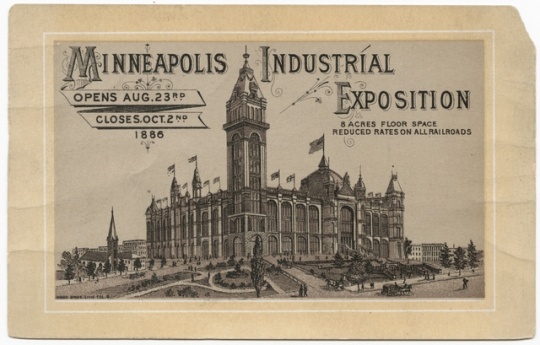
Exposition Building, Minneapolis
Public domain
Holding Location
More Information
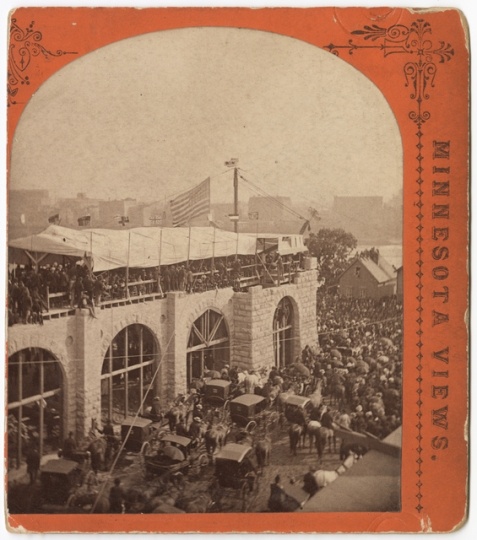
Laying the cornerstone of the Exposition Building, Minneapolis
Public domain
Holding Location
More Information
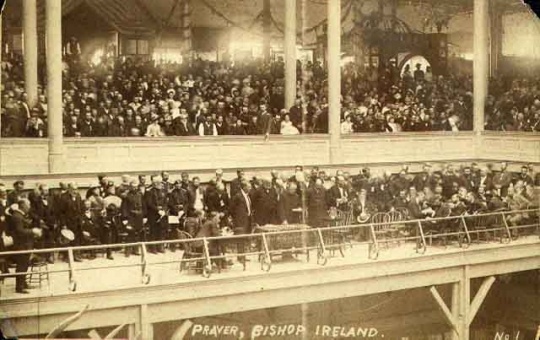
Archbishop John Ireland speaking at the dedication of the Exposition Building
Public domain
Holding Location
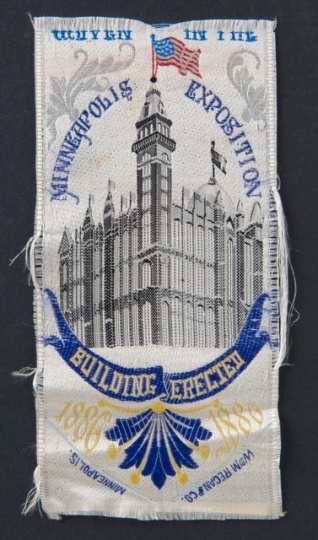
Minneapolis Industrial Exposition ribbon
All rights reserved
Holding Location
More Information
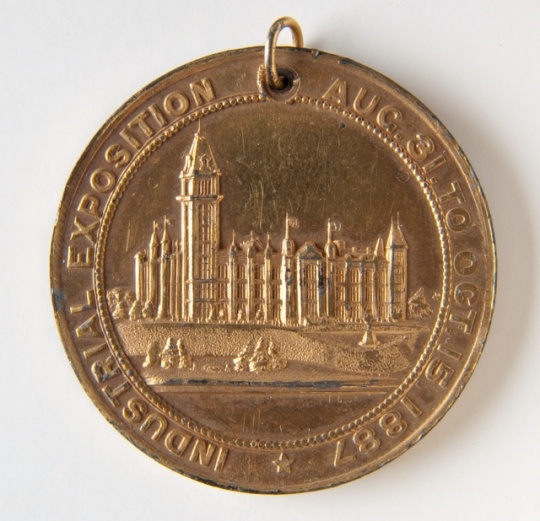
Minneapolis Industrial Exposition medal (front)
All rights reserved
Holding Location
More Information
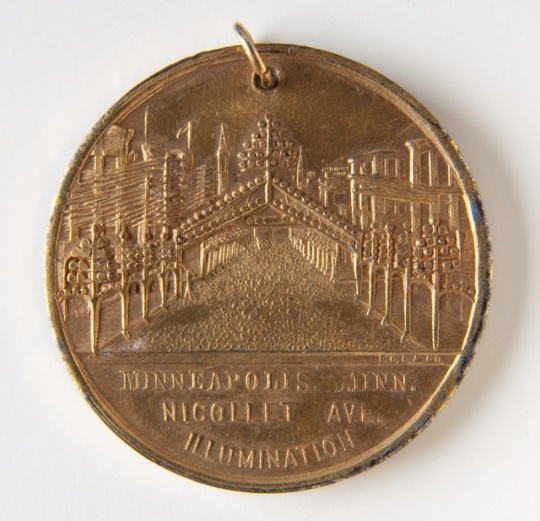
Minneapolis Industrial Exposition medal (back)
All rights reserved
Holding Location
More Information

Soo Line Railway passenger ticket
All rights reserved
Holding Location
More Information
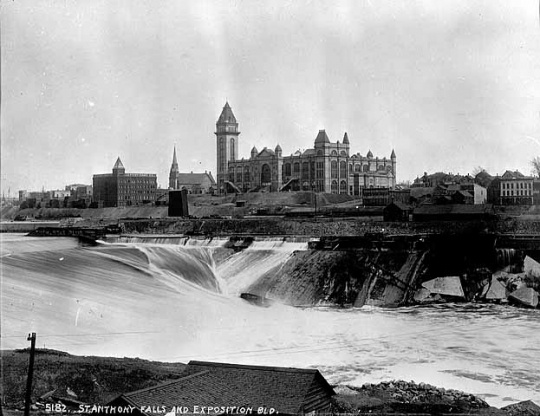
Exposition Building and St. Anthony Falls, Minneapolis
Public domain
Holding Location
More Information
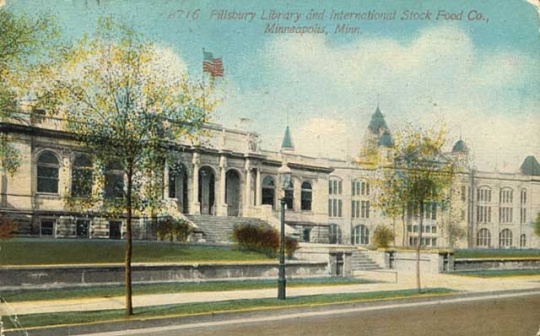
Pillsbury Library and Exposition Building
Public domain
Holding Location
More Information
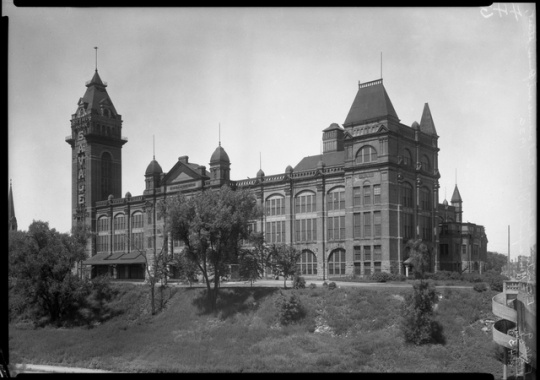
Exposition Building, Central Avenue and Prince Street, Minneapolis
Holding Location
More Information
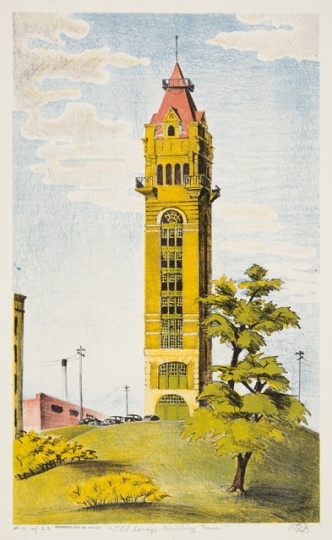
Old Savage Building Tower
Holding Location
More Information
Related Articles
Turning Point
The first Industrial Exposition opens in Minneapolis on August 24, 1886, and fulfills the city's ambitious vision for the Industrial Exposition Building.
Chronology
1885
1886
1892
1896
1903
1940
Bibliography
"Art for the Exposition." Minneapolis Tribune, June 16, 1886.
Atwater, Isaac, ed. History of the City of Minneapolis, Minnesota. 2 vols. New York: Munsell and Company, Publishers, 1893.
Ausenhus, Peter. "Civic Image and the building of the Minneapolis Industrial Exposition." PhD diss., University of Minnesota, 1996.
Berman, James, ed. Saint Anthony Falls Rediscovered. Minneapolis: Minneapolis Riverfront Development Coordination Board, 1980.
"The City: Enthusiastic Mass Meeting in Favor of the Industrial Exposition," Minneapolis Tribune, October 17, 1885.
Dees, Janis White. "Anna Schoen-Rene: Minnesota Musical Pioneer." Minnesota History 48, no. 8 (Winter 1983): 332–338.
http://collections.mnhs.org/MNHistoryMagazine/articles/48/v48i08p332-338.pdf
Edgar, Randolph. "Early Minneapolis Theaters." Minnesota History 9, no. 1 (March 1928): 31–38.
http://collections.mnhs.org/MNHistoryMagazine/articles/9/v09i01p031-038.pdf
"The Exposition." Minneapolis Tribune, May 29, 1886.
"Exposition." Minneapolis Tribune, August 24, 1886.
Holmquist, June Drenning. "Convention City: The Republicans in Minneapolis, 1892." Minnesota History 35, no. 2 (June 1956): 64–76.
http://collections.mnhs.org/MNHistoryMagazine/articles/35/v35i02p064-076.pdf
"Industrial Exposition." Minneapolis Tribune, September 22, 1885.
Landscape Research LLC. The Minneapolis Riverfront as Birth Place and First Place. Prepared for the Saint Anthony Falls Heritage Board, 2008.
"The Minnesota Scene." Minnesota History 36, no. 1(March 1958): 33.
Sherman, John K. "The Birth of a Symphony Orchestra." Minnesota History 33, no. 3 (Autumn 1952): 93–104.
http://collections.mnhs.org/MNHistoryMagazine/articles/33/v33i03p093-104.pdf
Thompson, Ruth. "Minnesota Memories." Minneapolis Tribune, October 8, 1945.
"Triumph!" Minneapolis Tribune, October 11, 1885.
Related Resources
Primary
P1547
George A. Brackett Papers, 1858–1920
Manuscript Collection, Minnesota Historical Society, St. Paul
Description: George Brackett was involved in planning the first Industrial Exposition in Minneapolis in 1886.
A/.G762I
Lewis A. Grant and Family Papers, 1781–1921
Manuscript Collection, Minnesota Historical Society, St. Paul
Description: Lewis A. Grant was a stockholder in the Minneapolis Industrial Exposition.
Art catalogue, 1891 Minneapolis Industrial Exposition, sixth annual exhibition. Minneapolis: Harrison and Smith, 1891.
Catalogue of paintings and casts from the antique, etc., 1889 Minneapolis Industrial Exposition. Minneapolis: Swinburne Print Co, 1889.
Catalogue of paintings of the art department, third Minneapolis Industrial Exposition. Minneapolis: Swinburne Print Co, 1888.
Catalogue of works of art and antiquities in the art galleries of the Minneapolis Industrial Exposition 1890. Minneapolis: Swinburne Print Co, 1890.
Chapin, Harold C. Minneapolis industrial and art exposition souvenir and illustrated hand book. Minneapolis: Baldwin, Bruce and Brundage, 1886.
Complete catalogue of the art department of the first Minneapolis Industrial Exposition. Minneapolis: Spectator Bureau of Print and Illustration, 1886
Complete catalogue of the art department of the second Minneapolis Industrial Exposition. Minneapolis: Swinburne Print Co, 1887.
Davis, Cushman K., "An address at the opening of the Minneapolis Exposition," delivered in Minneapolis, August 23, 1886.
Minneapolis Industrial Exposition. Serial. Minneapolis: various printers, 1886–1892.
"A Model Convention Hall." Minneapolis Journal, June 6, 1892.
Official program of attractions at the Minneapolis Industrial Exposition: from August 22nd to Sept. 29th, 1888, and the Minnesota State Fair from August 10th to August 17th, 1888. Minneapolis: C.E. Baldwin, 1888.
Our Navy and The Minneapolis Exposition of 1891. Germany, 1891.
Patten, Willard. The Minneapolis Exposition: grand march for the piano. Minneapolis: W.J. Dyer and Bro.
The Minneapolis Industrial Exposition reports for 1886 and prospectus of the second annual exposition: opening August 31, and closing October 15, 1887. Minneapolis: Swinburne, 1887.
Secondary
Shutter, Marion D. History of Minneapolis: Gateway to the Northwest. Vol. 1. Chicago: The S.J. Clarke Publishing Company, 1923.












